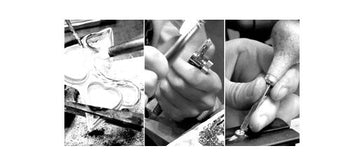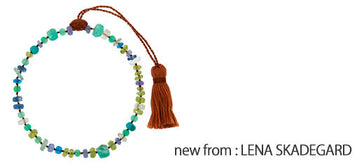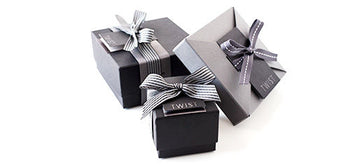Metals:
Gold:
Gold is a metallic chemical element with the symbol Au and the atomic number of 47. It is the most malleable of all metals, making it a favorite of jewelers all over the world. One gram can be hammered into 1 square meter, and one ounce can be pounded into 300 square feet. Chemically, it is unaffected by air, moisture, and most corrosive reagents. Gold standards have been the most common basis for monetary policies since early history but were replaced by flat currency during the 20th century. Gold has been highly sought after for jewelry making since the beginning of history. In medieval times, gold was believed to be beneficial to one's health. It can symbolize power, wealth, strength, happiness, warmth, love, hope, optimism, justice, balance, summer, sun, and harvest.
Traditionally, the three most popular colors of gold are yellow, rose, and white. Green gold is an up and coming color that is found in many items across Twist’s collection of artisan jewelry. Yellow gold occurs naturally and is the purest form of the metal. When used in jewelry making, it is combined with zinc or copper to form an alloy. Other colors of gold are created when different metals are used to form the jewelry alloy. Some of the amazing properties of white, rose, and green gold include:
- White Gold: White gold is an alloy of another white metal (like nickel or palladium) with gold. Its purity is signified in karats in the same manner as yellow gold. To maintain and/or enhance the white color of this gold, it is often plated with rhodium, which is a shiny white metal with extreme hardness. This coating, however, does wear off in time revealing the original color of the white gold.
- Rose / Pink Gold: This gold has a pinkish-rose color and is an alloy of gold and other metals - usually copper. The highest karat weight for rose gold is 22K and is referred to as crown gold. The higher the percentage of copper, the more intense the rose/pink/red tone will be. Eighteen karats rose gold is 75% gold and 25% copper.
- Green Gold: The green tone appears when copper is left out of the alloy and is, instead, a mixture of gold and silver. Cadmium can also be added to intensify the green color.
What is Karat Gold?
Unlike a carat, which is a unit of weight used for diamonds and other gemstones, a karat is classified as a unit of purity used to describe gold. The standard starts at 24 karat gold, which is pure gold. In jewelry-making, 24 karat gold is rarely used since the pure form of gold is too soft to hold a firm shape. When gold is mixed with another metal, each karat consists of 1/24th of the amount of gold. Gold jewelry typically falls under the following karats:
- 22 karat gold (22K) is 22 parts gold and 2 parts another metal or metals, making it 91% gold.
- 18 karat gold (18K) is 18 parts gold and 4 parts another metal or metals, making it 75% gold.
- 14 karat gold (14K) is 14 parts gold and 10 parts another metal or metals, making it 58.3% gold.
- 10 karat gold (10K) is 10 parts gold and 14 parts another metal or metals, making it 41.7% gold. This is the minimum karat designation for a metal to be called gold in the US.
Silver:
Silver is a metallic element with the chemical symbol Ag and atomic number 47. It is much less expensive than gold but used just as frequently in making jewelry. Silver often symbolizes purity, clarity, awareness, focus, and persistence. It is also associated with the moon and female energy.
Sterling silver is an alloy of 92.5% silver and 7.5% other metals, usually copper. It is often stamped with the numbers 925. For something to be considered silver, it must be at least 90% silver and 10% of another metal. This alloy is stamped with 900. Fine silver (99.9% silver) is far too soft for jewelry but can often be used as a decorative element in silver pieces.
TWIST carries a diverse collection of gold and silver earrings, rings, necklaces, and bracelets from some of the world’s most influential designers. To check out our selection in person, visit our locations in Portland and Seattle today!









